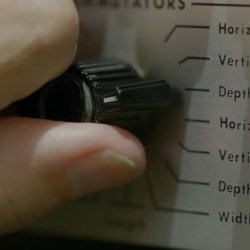Scanimate Analog Video Synths Produced Oceans of Motion Graphics

Why doesn’t this kind of stuff ever happen to us? One lucky day back in high school, [Dave Sieg] stumbled upon a room full of new equipment and a guy standing there scratching his head. [Dave]’s curiosity about this fledgling television studio was rewarded when that guy asked [Dave] if he wanted to help set it up. From that point on, [Dave] had the video bug. The rest is analog television history.
 Today, [Dave] is the proud owner and maintainer of two Scanimate machines — the first R&D prototype, and the last one of only eight ever produced. The Scanimate is essentially an analog synthesizer for video signals, and they made it possible to move words and pictures around on a screen much more easily than ever before. Any animated logo or graphics seen on TV from the mid-1970s to the mid-80s was likely done with one of these huge machines, and we would jump quite high at the chance to fiddle with one of them.
Today, [Dave] is the proud owner and maintainer of two Scanimate machines — the first R&D prototype, and the last one of only eight ever produced. The Scanimate is essentially an analog synthesizer for video signals, and they made it possible to move words and pictures around on a screen much more easily than ever before. Any animated logo or graphics seen on TV from the mid-1970s to the mid-80s was likely done with one of these huge machines, and we would jump quite high at the chance to fiddle with one of them.
Analog television signals were continuously variable, and much like an analog music synthesizer, the changes imposed on the signal are immediately discernible. In the first video below, [Dave] introduces the Scanimate and plays around with the Viceland logo a bit.
Stick around for the second and third videos where he superimposes the Scanimate’s output on to the video he’s making, all the while twiddling knobs to add oscillators and thoroughly explaining what’s going on. If you’ve ever played around with Lissajous patterns on an oscilloscope, you’ll really have a feel for what’s happening here. In the fourth video, [Dave] dives deeper and dissects the analog circuits that make up this fantastic piece of equipment.
Here’s another way to play with scan lines: delay the output to some of them and you have a simple scrambler.
Thanks for the tip, [morgan]!
Post a Comment